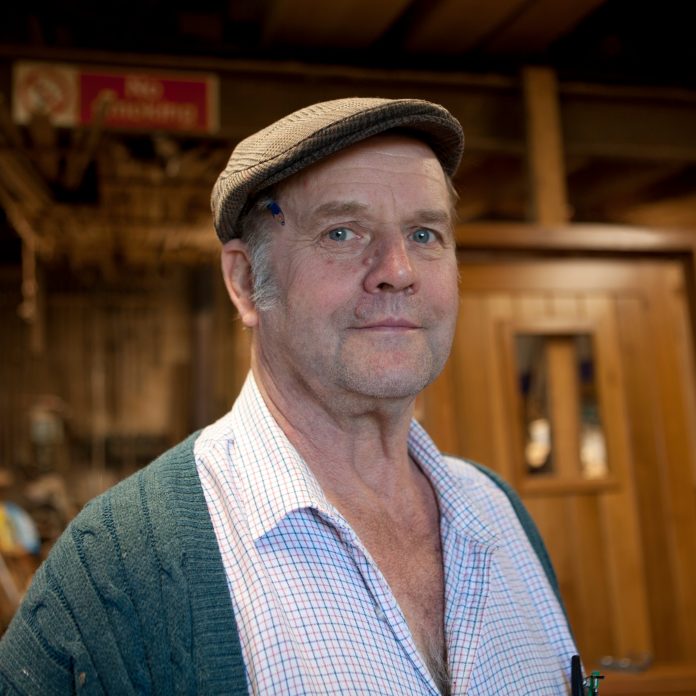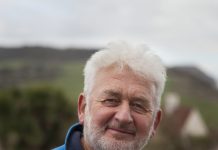‘My father’s family had a business at Beckington, near Frome, where they were carpenters/joiners and wheelwrights. After he’d left Frome Grammar School, Father came to Salwayash to stay with his uncle who ran Lower Kershay Farm, which is where he met Mother. At that time Father’s passion for sheep was inspired by neighbouring farmer Percy Warren who kept Dorset Horns. The business at Beckington has been going for generations; Father’s mother was a cheesemaker and farmed in her own right, as were his aunts.
There are two trades in our family: carpenters/wheelwrights/undertakers, which often went hand in hand, and farming. Father’s uncle, who he worked with, was actually born here in our house in Litton Cheney, where his father rented land locally for dairying. And I’ve got an older brother, who followed in Father’s footsteps and went shepherding.
As soon as I was able to carry half a bale of hay I had to go and help Father feed sheep. All his life, the topic of conversation with him was either sheep, heavy horses or farming, in that order. At 13 I was driving tractors, haymaking and harvesting, and helping with sheep work. Father’s work took him all round Dorset, and beyond. He worked for Charlie Borough’s at Halse in Somerset, then for Bill Hooper at Winfrith Newburgh, with Pedigree Dorset Downs. He went to Sussex looking after Kent Romney ewes, then to Rex Loveless’s at Piddlehinton with Dorset Downs again, then to Kingston Maurward to work with the college Dorset Horn flock, until they were sold. That was an old flock, a good one, and when Father was showing them he was giving Fooks’s at Powerstock, famous Dorset Horn breeders, a run for their money and occasionally beating them. He was a familiar sight at agricultural shows and markets, probably known to most Dorset farmers at the time in his flat cap, collar and tie, britches and highly polished brown leather gaiters. He had met members of the Royal Family, including HRH the Queen, the Chairman of Youngs Brewery and the Colonel of the Dorset Yeomanry, all of whom he advised about sheep, and would generally listen carefully to what you had to say about a farming matter before politely telling you how you were wrong. In 1982 after being made redundant from Kingston Maurward, he had the chance to rent a bit of ground in Litton Cheney, so we moved back here and he started his own small flock of Dorset Downs.
I went in the other family trade direction and have been a carpenter joiner all my life, and we do some wheelwrighting. From a young age I wanted to be a carpenter. With a piece of wood, a hammer and some nails, I was happy. After I left school I got a job in Dorchester with an old building firm called CE Slade’s, based down in Millers Close. That was in the days when there were some decent building firms in Dorchester, like Cake’s, Ricardo’s, Angell’s, all very good builders with their own joinery shops. I started in 1970 with Slade’s and soon got into the joinery side of it. I did my apprenticeship there, stayed on a few years, and left in 1978. I’d got married in ’77, like Father to a young lady from Salwayash, Carol, and then went to work for CG Fry’s down the road here in Litton Cheney. I was foreman joiner for them for about 8 years, then left and started on my own in 1986.
Father could always remember his father making wheels, and his brother who was older was involved, but basically the war killed the trade. That was because there were so many rubber-tyred wheels left over from the military which could be reused, tractors were becoming much more common, and when the wooden wheels on the old wagons got shaky they didn’t get replaced. I got interested in making wheels probably 40-odd years ago, and today we both repair old wheels and make new ones. There are still enough old farm wagons in preservation, horse-drawn traps, hand carts, trolleys, etc to provide us with an interesting sideline. To make a new wheel, you start by turning out the hub on the lathe, and that’s always English elm. Then you set out the spokes, always an even number, and fit the iron stock hoops to the hub and drive them on tight. Having morticed the hub for the spokes, you then make them out of English oak, shape them, and fit them by driving them really tight into the hub mortices. There’s never any glue involved. Next job is to cut the felloes (pronounced fellies) out, always English ash. These are the curved sections of the wheel rim, each one joined to the next one with a dowel. The different timber species are used for good reason; the elm is tough and stringy, resistant to splitting even though much of the hub has been removed to take the spokes. Oak is strong, to resist the impact of the weight on the wheel riding over bumps, all of which is on one spoke as it reaches the lowest point of the rotation; and ash is springy, to absorb the weight as the wheel turns. Each of the spokes is cut to length with a “tang” or round tenon on the end, and fitted to holes drilled into the felloes, two to a felloe. There has to be a small gap between the felloes, and in the length of the spokes, so that when the hot bond, or iron tyre, is fitted, the gaps will squeeze up tight as it cools and contracts with enormous force. We do all that ourselves, building a fire round the bond to heat it up before fitting.
On the joinery side, we’ve done some interesting projects. We built a complete horse-drawn hearse once, for Mac Kingman in Weymouth, which he used regularly for many years. There’ve been a few canopies for steam engines, too, and repairs to thrashing machines, including a total rebuild of one, and wooden parts for old farm machines like binders, and years ago a lot of con-rods for the old finger-bar mowers, for Lott and Walne in Dorchester. If it wasn’t for fools like us, and the fools who still have these old machines, it’d all be gone for ever, and it’s part of our heritage; most of the modern machines have simply evolved from these old designs. We’ve also made big Georgian staircases with endless strings, or handrails, which curve in different directions, the last one in Winterborne Keynstone, and spiral staircases too. A helical staircase in a round building was an interesting project once.
Our business is very traditional, and that’s because I’m a bit old fashioned about the way building is done today. Everything has to be done in such a tearing hurry, using products which enable things to be built quickly, as a result of which it often doesn’t last very long. I was taught by some very skilled tradesmen, the sort of people who are hard to find any more, when things were made in tried and tested ways, which for many years had stood the test of time. I still work on those lines, which sometimes leads to arguments with clients and architects, and occasionally I will refuse to price a job if they insist on building something in a way I know won’t last. Traditional ways of building and joinery are done for good reasons, and Chris and I take great pride in what we do. That extends to the tools we use, still sharpening our own saws rather than buying another one with a plastic handle as most carpenters do.
Carol and I have 3 boys, and Christopher decided just before he left school he wanted to follow me in my work, the 6th generation in our family to take up the trade. It was difficult to find a good apprenticeship place for him, so at the time slightly against my better judgement he came to work with me, and has been here ever since. He’s the same as me, in that the work’s got to be right. Nothing leaves the workshop until we’re happy with it, even if we have to spend another day on it.’










